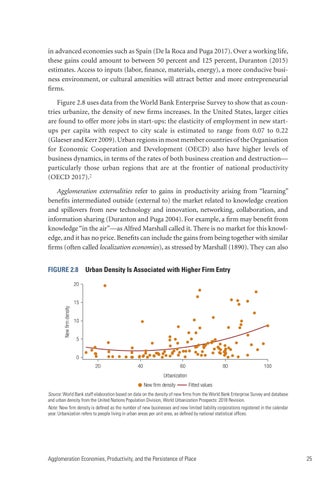in advanced economies such as Spain (De la Roca and Puga 2017). Over a working life, these gains could amount to between 50 percent and 125 percent, Duranton (2015) estimates. Access to inputs (labor, finance, materials, energy), a more conducive business environment, or cultural amenities will attract better and more entrepreneurial firms. Figure 2.8 uses data from the World Bank Enterprise Survey to show that as countries urbanize, the density of new firms increases. In the United States, larger cities are found to offer more jobs in start-ups: the elasticity of employment in new startups per capita with respect to city scale is estimated to range from 0.07 to 0.22 (Glaeser and Kerr 2009). Urban regions in most member countries of the Organisation for Economic Cooperation and Development (OECD) also have higher levels of business dynamics, in terms of the rates of both business creation and destruction— particularly those urban regions that are at the frontier of national productivity (OECD 2017).7 Agglomeration externalities refer to gains in productivity arising from “learning” benefits intermediated outside (external to) the market related to knowledge creation and spillovers from new technology and innovation, networking, collaboration, and information sharing (Duranton and Puga 2004). For example, a firm may benefit from knowledge “in the air”—as Alfred Marshall called it. There is no market for this knowledge, and it has no price. Benefits can include the gains from being together with similar firms (often called localization economies), as stressed by Marshall (1890). They can also FIGURE 2.8 Urban Density Is Associated with Higher Firm Entry 20
New firm density
15 10 5 0 20
40
60
80
100
Urbanization New firm density
Fitted values
Source: World Bank staff elaboration based on data on the density of new firms from the World Bank Enterprise Survey and database and urban density from the United Nations Population Division, World Urbanization Prospects: 2018 Revision. Note: New firm density is defined as the number of new businesses and new limited liability corporations registered in the calendar year. Urbanization refers to people living in urban areas per unit area, as defined by national statistical offices.
Agglomeration Economies, Productivity, and the Persistence of Place 25

